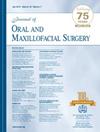Condyle Preservation in Patients With Mandibular Resection Is Associated With Enhanced Quality of Life and Function
IF 2.3
3区 医学
Q2 DENTISTRY, ORAL SURGERY & MEDICINE
引用次数: 0
Abstract
Background
Operative treatment of advanced mandibular tumors may require excision of a portion of the mandible including the condyle. It is not clear how condylar excision affects postoperative quality of life (QoL).
Purpose
The study purpose was to measure the association between operative management of the condyle and postoperative health-related QoL and temporomandibular joint (TMJ) function.
Study design, setting, and sample
This prospective cohort study included patients with benign mandibular lesions who underwent hemi-mandibulectomy and were treated at Taleghani and Imam Hossein Hospitals in Tehran, Iran. Patients were excluded from the study if they had a history of preoperative or postoperative radiotherapy and chemotherapy, previous TMJ surgery or trauma, autoimmune diseases that affect TMJ function, bruxism or clenching, previous TMJ problems such as degenerative joint disease, failed to return for follow-up, or refused study enrollment.
Predictor variable
The predictor variable was operative management of the condyle and it was grouped into 2 levels, preserved or resected.
Main outcome variable(s)
The primary outcome was the oral health-associated QoL, which was determined using the Oral Health Impact Profile-14 questionnaire. Secondary outcome variables included maximum mouth-opening values, visual analog scale pain score, joint clicking, and joint crepitus. Outcome variables were determined pretreatment, immediately postsurgery, and 6 and 12 months postsurgery.
Covariates
Age, sex, and defect size were the study covariates.
Analyses
Repeated measures analysis of variance was conducted to compare QoL questionnaire scores, maximum mouth opening, and visual analog scale pain scores (P < .05).
Results
The sample was composed of 46 subjects. Mean age was 46 ± 13.1 years in both groups and 25 patients (54%) were male. Presurgery QoL scores were 79.22 ± 1.72 for the resection group and 82.38 ± 1.21 for the preservation group (P = .6). At 12 months postsurgery, QoL, maximum mouth-opening, and pain scores were 65.89 ± 3.82, 31.56 ± 2.30, and 5.44 ± 2.45 for the resection group, while the preservation group showed significantly better scores with 78.69 ± 2.10, 40.77 ± 2.20, and 1.15 ± 0.90, respectively (P < .001 for all).
Conclusion and relevance
Condyle preservation in resection treatments is associated with higher QoL scores, reduced TMJ pain, and increased maximum mouth opening. Preservation of the condyle should be considered during surgery whenever possible.
下颌切除术患者保留髁突与提高生活质量和功能相关。
背景:晚期下颌骨肿瘤的手术治疗可能需要切除下颌骨的一部分,包括髁突。目前尚不清楚髁突切除如何影响术后生活质量(QoL)。目的:研究目的是测量髁突手术处理与术后健康相关生活质量和颞下颌关节(TMJ)功能之间的关系。研究设计、环境和样本:这项前瞻性队列研究包括在伊朗德黑兰Taleghani和Imam Hossein医院接受半下颌切除术的下颌良性病变患者。如果患者术前或术后有放疗和化疗史,既往TMJ手术或创伤,影响TMJ功能的自身免疫性疾病,磨牙或握紧,既往TMJ问题如DJD,未能返回随访或拒绝研究入组,则排除在研究之外。预测变量:预测变量为髁突的手术处理,分为2个水平,保留或切除。主要结局变量:主要结局是口腔健康相关的生活质量,使用口腔健康影响概况-14问卷确定。次要结果变量包括最大张嘴值、视觉模拟疼痛评分、关节咔嗒声和关节抖。结果变量分别为术前、术后即刻、术后6个月和12个月。协变量:年龄、性别和缺陷大小是研究的协变量。分析:采用重复测量方差分析比较生活质量问卷得分、最大张嘴量和视觉模拟量表疼痛评分(P)结果:样本由46名受试者组成。两组患者平均年龄为46±13.1岁,男性25例(54%)。手术前生活质量评分:切除组79.22±1.72,保留组82.38±1.21 (P = 0.6)。术后12个月,切除组的生活质量、最大开口和疼痛评分分别为65.89±3.82、31.56±2.30和5.44±2.45,而保留组的生活质量、最大开口和疼痛评分分别为78.69±2.10、40.77±2.20和1.15±0.90,明显高于保留组(P)。结论及相关性:保留髁髁切除治疗的生活质量评分较高,TMJ疼痛减轻,最大开口增加。手术时应尽可能考虑保留髁突。
本文章由计算机程序翻译,如有差异,请以英文原文为准。
求助全文
约1分钟内获得全文
求助全文
来源期刊

Journal of Oral and Maxillofacial Surgery
医学-牙科与口腔外科
CiteScore
4.00
自引率
5.30%
发文量
0
审稿时长
41 days
期刊介绍:
This monthly journal offers comprehensive coverage of new techniques, important developments and innovative ideas in oral and maxillofacial surgery. Practice-applicable articles help develop the methods used to handle dentoalveolar surgery, facial injuries and deformities, TMJ disorders, oral cancer, jaw reconstruction, anesthesia and analgesia. The journal also includes specifics on new instruments and diagnostic equipment and modern therapeutic drugs and devices. Journal of Oral and Maxillofacial Surgery is recommended for first or priority subscription by the Dental Section of the Medical Library Association.
 求助内容:
求助内容: 应助结果提醒方式:
应助结果提醒方式:


